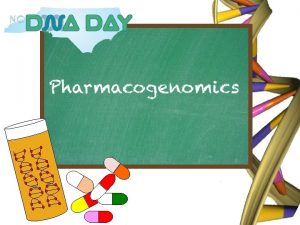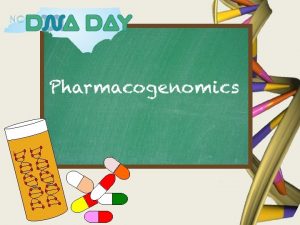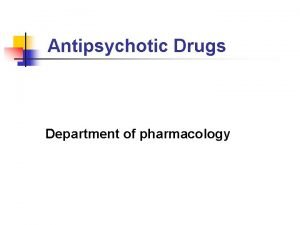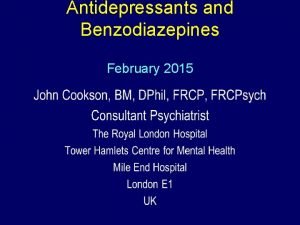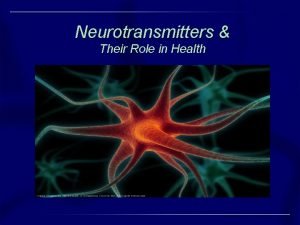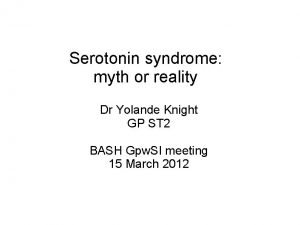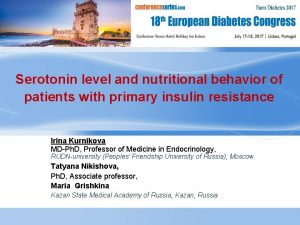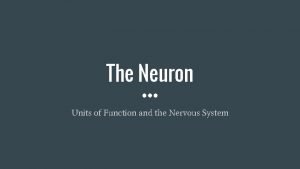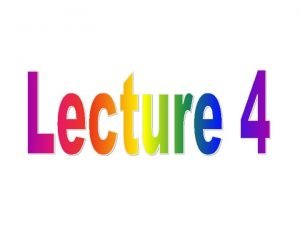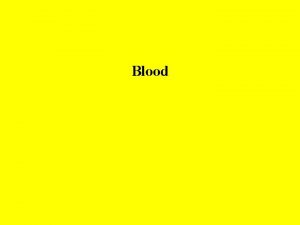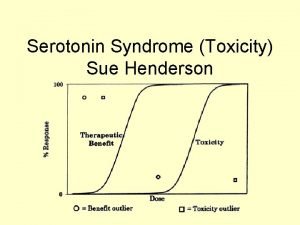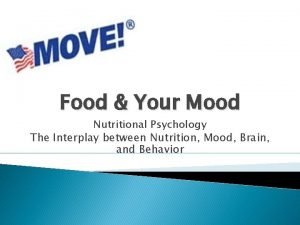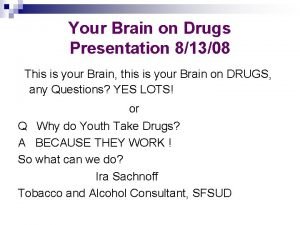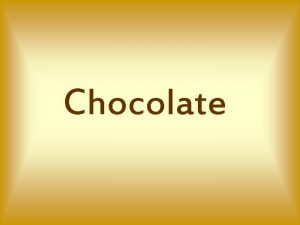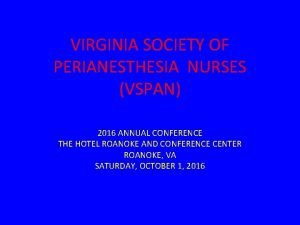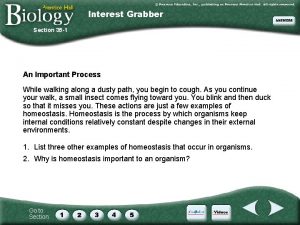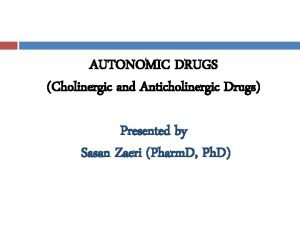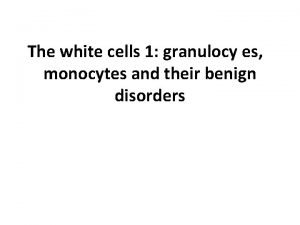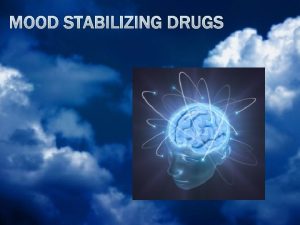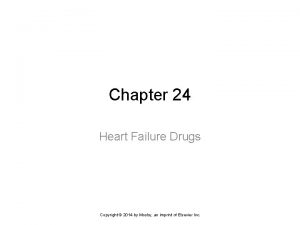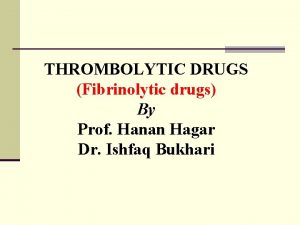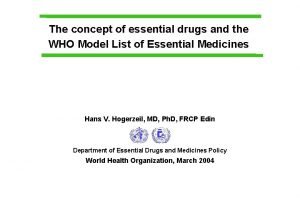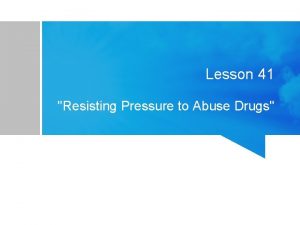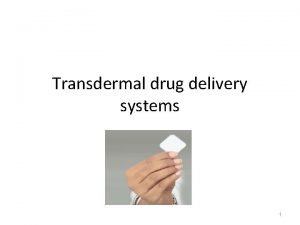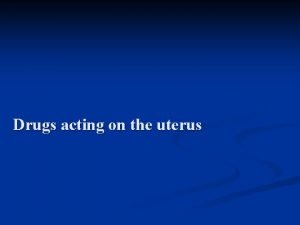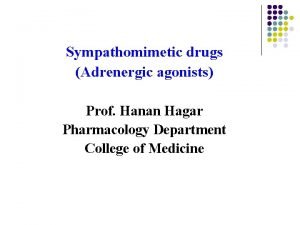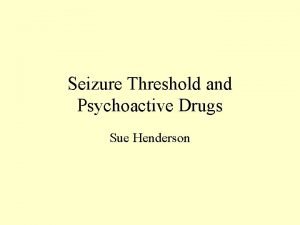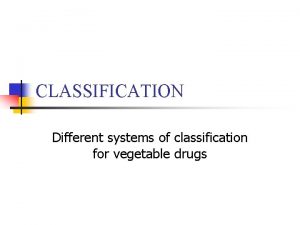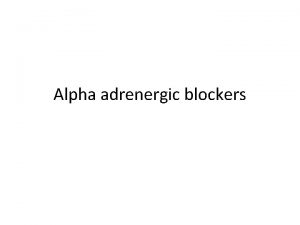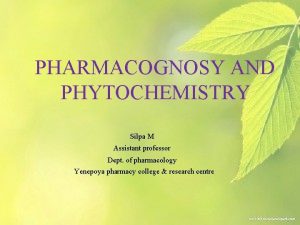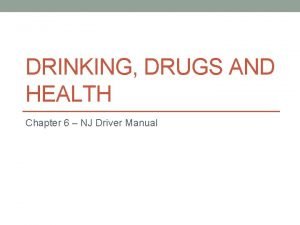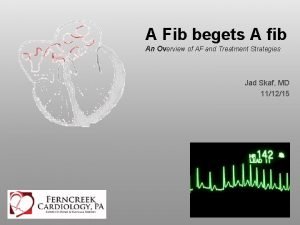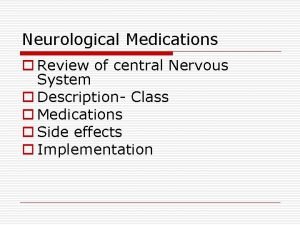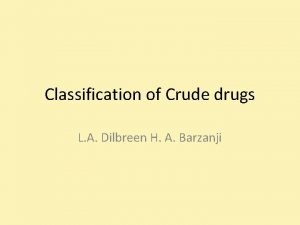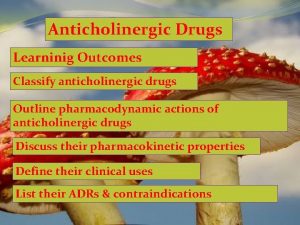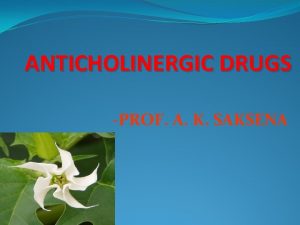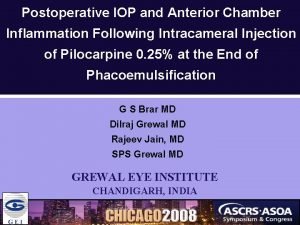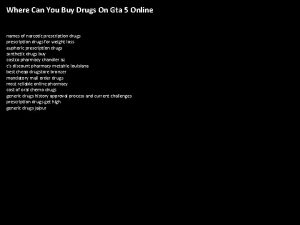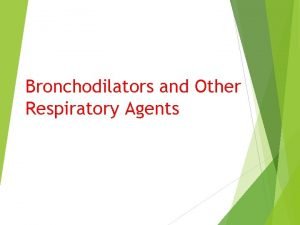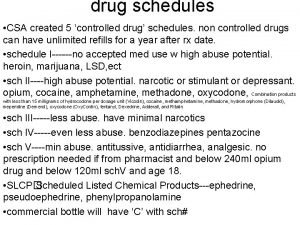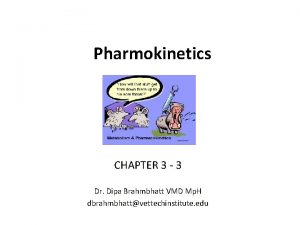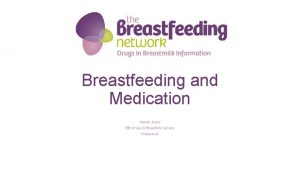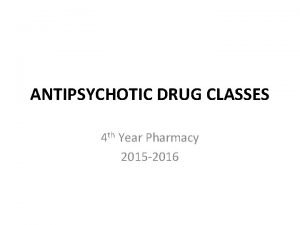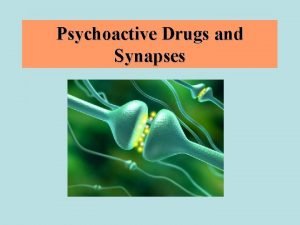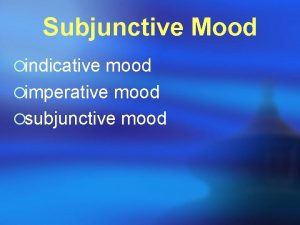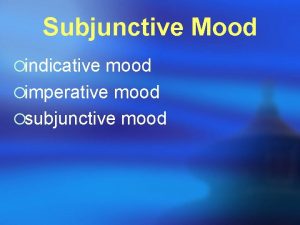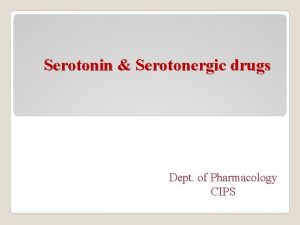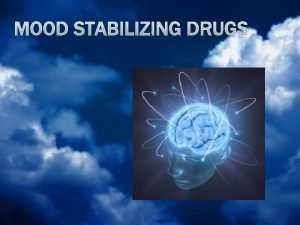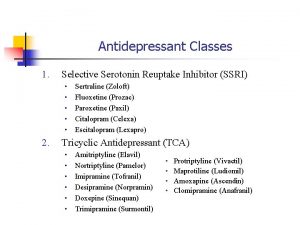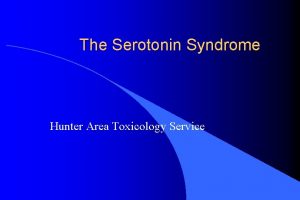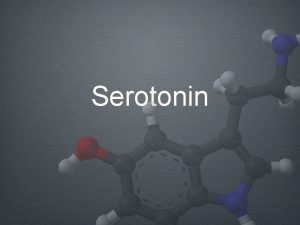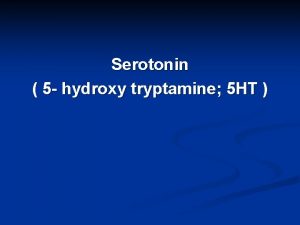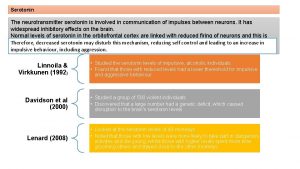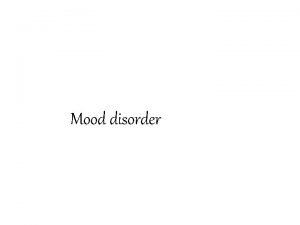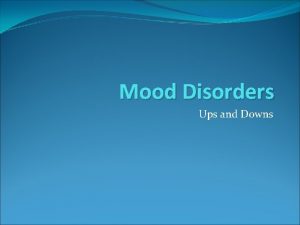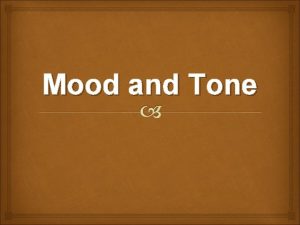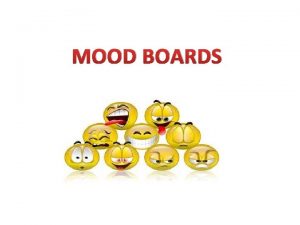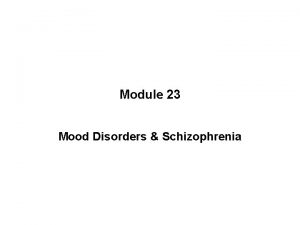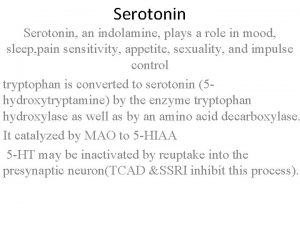Antidepressant Drugs Serotonin 5 HT MOOD NA DA
















































- Slides: 48

Antidepressant Drugs

Serotonin (5 -HT) MOOD NA DA

Depression • Activity of NE and 5 -HT systems

Classification of Major Affective Disorders

Depression ¨ feelings of misery ¨ apathy ¨ inadequacy ¨ pessimism ¨ anxiety ¨ tension ¨ Guilt ¨ Ugliness ¨ Bodily complaints ¨ Low self –esteem ¨ Indecisiveness ¨ Ioss of motivation ¨ Retardation of thought and action ¨ Sleep disturbance

• In severe cases, it is accompanied by hallucinations and delusions. • Recurrent suicidal ideation, a suicide attempt or a specific suicide plan. • significant weight change (without dieting ) • Psychomotor agitation or retardation.

Mania alone is rare (10%) and most frequently cycles with Major/endogenous depression (Manic-Depressive Disease, Bipolar Disorder). Core Symptoms: ØCharacterized by an elevated “high” mood. ØTalkative, go on-and-on about the things they will do. ØIncreased self-esteem. ØAuditory hallucinations. ØDecrease need to sleep. Expensiveness, unnecessary buying. ØLack judgment, Superman, spiderman.

Almost all NE pathways in the brain originate from the cell bodies of neuronal cells in the locus coereleus in the midbrain, which send their axons diffusely to the cortex, cerebellum and limbic areas (hippocampus, amygdala, hypothalamus, thalamus). ØMood: -- higher functions performed by the cortex. ØCognitive function: -- function of cortex. ØDrive and motivation: -- function of brainstem ØMemory and emotion: -- function of the hippocampus and amygdala. ØEndocrine response: -- function of hypothalamus.

Serotonin System As with the NE system, serotonin neurons located in the pons and midbrain (in groups known as raphe nuclei) send their projections diffusely to the cortex, hippocampus, amygdala, hypothalamus, etc. --same areas implicated in depression. This system is also involved in: • • Anxiety. Sleep. Sexual behavior. Temperature regulation.


Blocked by antidepressant s

Serotonin receptors n 5–HT 1 n subtypes n n n 5–HT 1 A, 5–HT 1 B, 5–HT 1 D, 5– HT 1 E, 5–HT 1 F primarily responsible for therapeutic (antidepressant) effects of increased intrasynaptic serotonin 5–HT 2 n subtypes n n 5–HT 2 A, 5–HT 2 B, 5–HT 2 C primarily responsible for the toxic effects of increased intrasynaptic serotonin

Serotonin receptors • Over all 14 types divided in to 1, 2, 3, and 4 -7 family • All are G-protein coupled receptors except 3 • 1 - decreases c. AMP while 4 -7 increase • 2 - generation of IP 3/DAG • 3 - ligand gated cation channel

? Reversible inhibitor of MAO-A (RIMAs) Moclobemide , Clorgyline • (Isocarboxacid, phenelzine, tranylcypromine. ) ? Tricyclic antidepressants NA + 5 HT reuptake inhibitor Imipramine, Amitriptyline Trimipramine, Doxepin, Dothiepin, Clomipramine (TCAs) Predominantly NA reuptake inhibitor Desipramine, Nortriptyline Amoxapine, Reboxetine ? Selective serotonin reuptake ? Atypical antidepressants inhibitors (SSRIs) Fluoxetine, Fluvoxamine Paroxetine, Sertraline Citalopram, Escitalopram Trazodone, Mianserine Mirtazapine, Venlafaxine Duloxetine, Tianeptine Amineptine, Bupropion A N T ID E P R E S S A N T S


Mechanism of Action 1. Inhibition of MAO enzymes. (MAOIs). A T Y P I C A L 2. Inhibition of NE and 5 -HT reuptake. (TCAs, SSRIs, Newer TCAs). 3. Prominent alpha blocking and weak 5 -HT 2 antagonists. (Nefazodone, trazodone, ) 4. Serotonin and noradrenalin reuptake inhibitor (SNRIs) (venlafaxine, duloxetine) 5. Noradrenergic and specific serotonergic antidepressants (Na. SSA) (Mirtazapine) 6. Inhibitor of Dopamine and Noradrenalin uptake (Bupropion) 7. Blockade of pre-synaptic alpha 2 receptors (Mianserin) 8. Increases rather than inhibiting 5 -HT uptake (Tianeptine, Amineptine)

MAO ( monoamine oxidase) an enzyme Two types • MAO – A -Peripheral adrenergic nerve endings -Intestinal mucosa -Human placenta -Liver -Serotonin , Noradrenalin and dopamine -Inhibited by • MAO-B -brain ( basal ganglia) -Platelets -Liver -Deaminates dopamine -Inhibeted by selegiline (deprenyl) moclobemide and clorgyline Isoniazide, iproniazide, phenelzine, isocarboxazide, tranylcypromine were non selective and irreversible inhibitors (Hit and run drugs) used previously but not used now due to drug and drug food interactions. Linezolide (new drug against MRSA) Cheese and serotonin syndrome


Nonselective MAOIs not favorable Cheese Reaction Cheese, beer, wine, meat, fish, yeast, (contain large amount of tyramine and other indirectly acting amines) Due to irreversible block of MAO These escape degradation in intestinal wall and liver • Hypertensive crises, Reach to circulation Displace large amount of noradrenalin from loaded nerves CVA • Medical Emergency Tt. I. V. Phentolamine, Prazosin

Nonselective MAOIs not favorable – Cold and Cough medicines contain Ephedrine (Same result as cheese reaction)

Reversible inhibitor of MAO-A (RIMAs) • Moclobemide–Reversible and selective MAO-A inhibitor –Short duration of action –Competitive enzyme inhibition –Tyramine is able to displace it –Cheese reaction is less likely –Devoid of anticholenergic, sedative, cognitive, cardiovascular effects –Good for elderly with heart diseases

Tricyclic Antidepressants (TCAs) • Imipramine represents the class (Prototype) • Inhibit monoamine reuptake (serotonin and noradrenaline) Serotonin and NA at • Increase the concentration of synapse and potentiate the action (therapeutic effects) • Other receptors acted (Adverse effects) » Muscarinic- Anticholinergic side effects (dryness etc. ) » Alpha receptor blocking actions (postural hypotension etc. ) » Histamine-Antihistaminic (sedation) » Dopamine- antipsychotic (amoxapine, maprotiline)

TCAs actions (CNS) • In Normal person • In Depressed - -Sedation immediately -Elevation of mood (24 Weeks) -Suppresses REM -prolongs total sleep duration Tiredness Light-headedness Sleepiness Difficulty in thinking Difficulty in concentration, - Gait disturbances - Provoke anxiety - Unpleasant Lower seizure threshold and produce convulsions in overdose Don’t carry abuse potential, Development of dependence is less

TCAs uptake blockade is not directly responsible for antidepressant action? • Uptake blockade occurs quickly but antidepressant action occurs after months • Initially Pre synaptic alpha 2 and 5 -HT 1 auto receptors are activated by increased amount of NA and Serotonin in synaptic cleft -resulting in decreased firing • But on long term desensitize and down regulation of these receptors and induce adaptive changes in the number and sensitivity of receptors and amine turnover leading to enhanced NA and Serotonin transmission required for antidepressant action.

• Signaling via NE or 5 -HT increases the expression of brain-derived neurotrophic factor (BDNF) • BDNF- related to the ultimate mechanism of action of antidepressant drugs • Increase in BDNF levels increased neurogenesis in the hippocampus

TCAs Adverse effects • Anticholinergic- dry mouth, bad taste, • • constipation, epigastric fullness, urinary retention (more common in elderly male), blurred vision, palpitation Sedation, mental confusion, weakness Increased appetite and weight Sweating, fine tremors Precipitation of seizures Postural hypotension Cardiac arrhythmias Rashes and jaundice (mianserin)

TCAs (Acute Poisoning) • Usually suicidal attempt • Presents as – Excitement – delirium – Anticholinergic symptoms like atropine poisoning – Muscle spasm – Convulsions – arrhythmias – Respiratory depression – Coma • Treatment Gastric lavage I. V. line Oxygen Maintenance of BP and Temperature – Diazepam iv – Propranolol / lignocaine – –

Miscellaneous • Amoxapine – Blocks D 2 + inhibition of NA reuptake – Has mixed antidepressant and neuroleptic effects – Good for psychotic depression • Reboxetine • Selective NA reuptake blocker • Weak action on 5 -HT mechanism • Anticholinergic effects are minimal

Selective Serotonin Reuptake Inhibitors (SSRIs) • Limitations of TCAs – – – – – • Answers may be given by SSRIs Anticholinergic effects • Selectively inhibit SERT (serotonin transporter) Alpha blocking action • More tolerability and better Cardio toxicity acceptability Sedation, seizures ppt • Used in depression as well as in OCD, phobias Low safety margin • No sedation, No seizure ppt Weight gain • No alpha blocking action Therapeutic window • Less chances of arrhythmia Overdose poisoning • No weight gain common • Now 1 st choice for OCD, Panic disorders, Social Phobia, Eating disorders, Lag of 1 month period Premenstrual syndrome, Post traumatic Incomplete response to stress Tt

Important points ØTCAs have slightly more efficacy ØSome patients not responding to TCAs respond to SSRIs, may ØSSRIs preferred in prophylaxis of recurrent depression ØIn severe depression TCAs appear to be more efficacious

Individual compounds • Fluoxetine – Prototype of SSRIs – Longest acting • Paroxetine • Short acting • More GI side effects q. Citalopram • Similar to sertraline but should be avoided in patients attempting suicide • Fluvoxamine – Short acting – Commonly used in indoor patients • Sertraline • Less chances of drug interactions due to low potency to cause cytochrome enzyme depression

SSRIs • Side effects • Gastric upset • Nausea • Interfere with ejaculation • Nervousness • Restlessness • Insomnia • Anorexia • Headache • Diarrhea • Epistaxis • Ecchymosis • Others • Inhibit cytochrome enzymes and elevate the plasma level of other drugs • Other serotonergic drug ( MAOIs) is taken may precipitate Serotonin Syndrome manifesting as agitation, restlessness, sweating, twitching, convulsions

Atypical Antidepressants • Trazodone • Mianserin – Blocks 5 -HT uptake – Has prominenent alpha blocking – potent 5 -HT 2 antagonist – No anticholinergic effect – Bradycardia – Has anxiolytic action also – Prolonged and painful penile erection (priapism) – Unique not inhibit NA and 5 -HT uptake – Blocks pre-synaptic alpha 2 receptors increases release and turnover of NA – Antagonist at serotonin 2, 1 c, and H 1 receptors – Has sedative effect – Damages liver and bone marrow (Reserve drug)

Atypical Antidepressants • Tianeptine / and Amineptine – Increases rather inhibiting 5 -HT uptake – Neither sedative nor stimulant – Effective in anxiodepressive states • Mirtazapine (Na. SSA) – Noradrenergic and specific serotonergic antidepressant – Blocks alpha 2 auto receptor (on NA neuron) and hetero(on 5 -HT neuron) receptors increasing both NA and serotonin release. • Duloxetine – Duloxetine increases uretheral tone, used in urinary incontinence ( over active bladder) – Used in panic attacks, diabetic neuropathic pain • Bupropion – Inhibits DA and NA uptake has excitant effect – Used to reduce smoking

Antidepressant uses • Depression (ECT may be needed in severely depressed and patients having suicidal tendency) • Bipolar affective disorders- TCAs and lithium or SSRIs with lithium or valporate/ lamotrigine • SSRIs with atypical antipsychotic in psychotic depression • Obsessive compulsive disorders (SSRI and Clomipramine) • Eating disorders

• Anxiety disorders • Neuropathic pain • Attention deficit hyperactivity disorder in children • Enuresis- (Imipramine 25 mg at night) • Overactive bladder (stress incontinence)Duloxetine • Migraine prophylaxis (Amitriptyline) • Pruritus (Topical doxepin)

Mania and MDI Treatment • Lithium • Carbamazepine • Sodium Valproate • Lamotrigine • Topiramate • Gabapentin • Olanzapine, aripiprazole, quetiapine

Lithium Øinhibition of inositol monophosphatase Ødecreased cerebral inositol concentrations Øsuppresses inositol signaling Øinhibits glycogen synthase kinase-3 (GSK-3), a multifunctional protein kinase. ØGSK-3 is a component of diverse intracellular signaling pathways. Dec NA and DA, Without affecting 5 -HT release

S/E of Lithium • • • Tremors seizures Diabetes incipidus Goiter, Hypothyroidism C/I during pregnancy- may cause congenital abnormalities (cardiac) • TDM is required (maintained level 0. 5 - 0. 8 m. Eq/L) Toxicity appears when serum level exceeds 1. 5 m. Eq/L

MCQs Q 1. Monitoring of serum lithium concentration is done because of: A. Low therapeutic efficacy B. Adverse effects C. Long half-life D. Very low therapeutic index Ans- D. Very low therapeutic index

Q 2. Long term use of lithium causes: A. Peripheral neuropathy B. Hypothyroidism C. Anemia D. Jaundice Ans- B

Q 3. Most common congenital anomaly associated with lithium is: A. Cardiac malformations B. Neural tube defects C. Renal anomaly D. Fetal hydantoin syndrome Ans- A

Q 4. Antidepressant, which is also useful in the treatment of neuropathic pain and migraine is A. Amitriptyline B. Amoxapine C. Reboxetine D. Sertraline Ans- A

Q 5. Which of the following antidepressant drug can also be used for treatment of anxiety, panic disorder, obsessive compulsive disorder and posttraumatic stress disorder? A. Bupropion B. sertraline C. reboxetine D. Moclobemide Ans- B

Q 6. Antidepressants are not recommended as monotherapy for bipolar illness because of A. ineffectiveness B. electroconvulsive therapy is the modality of choice in such patients C. weight gain D. the "switch" from a depressed episode to a manic or hypomanic episode Ans- D

Q 7. Electroconvulsive therapy (ECT) is treatment of choice for agitated, depressed patients with a high risk of suicide because A. ADRs are common due to antidepressant drugs B. antidepressant drugs are not effective C. antidepressant drugs takes 3 -4 weeks before a measurable therapeutic response becomes evident D. antidepressant drugs are not palatable Ans- C

Bibliography • Essentials of Medical Pharmacology -7 th edition by KD Tripathi • Goodman & Gilman's the Pharmacological Basis of Therapeutics 12 th edition by Laurence Brunton (Editor) • Lippincott's Illustrated Reviews: Pharmacology - 6 th edition by Richard A. Harvey • Basic and Clinical pharmacology 11 th edition by Bertram G Katzung • Rang & Dale's Pharmacology -7 th edition by Humphrey P. Rang • Clinical Pharmacology 11 th edition By Bennett and Brown, Churchill Livingstone • Principles of Pharmacology 2 nd edition by HL Sharma and KK Sharma • Review of Pharmacology by Gobind Sparsh

Thanks
 Antidepressant side effects
Antidepressant side effects Antidepressant side effects
Antidepressant side effects Orthostatic hypotensin
Orthostatic hypotensin Snri vs ssri
Snri vs ssri Serotonin function
Serotonin function Function of excitatory neurotransmitters
Function of excitatory neurotransmitters Serotonin syndrome nejm
Serotonin syndrome nejm Serotonin obesity
Serotonin obesity Serotonin
Serotonin Glycine serotonin
Glycine serotonin Plusmama.ru/analysis/serotonin-v-krovi
Plusmama.ru/analysis/serotonin-v-krovi Serotonin definition
Serotonin definition Dopamine and serotonin pathways
Dopamine and serotonin pathways Serotonin vs dopamine
Serotonin vs dopamine Serotonin and chocolate
Serotonin and chocolate Transcyclopromine
Transcyclopromine Section 35-5 drugs and the nervous system answer key
Section 35-5 drugs and the nervous system answer key Cholinergic drugs
Cholinergic drugs Myelofi
Myelofi Atypical antipsychotics drugs
Atypical antipsychotics drugs Chapter 24 heart failure drugs
Chapter 24 heart failure drugs Thrombolytic drugs
Thrombolytic drugs Antihypertensive drugs classification
Antihypertensive drugs classification Essential drug concept in pharmacology
Essential drug concept in pharmacology Resisting pressure to abuse drugs is a responsible .
Resisting pressure to abuse drugs is a responsible . Factors affecting dermal penetration of drugs
Factors affecting dermal penetration of drugs Uterus stimulant drugs
Uterus stimulant drugs Sympathomimetic
Sympathomimetic Seizure threshold definition
Seizure threshold definition Vegetable drugs
Vegetable drugs Antithyroid drugs
Antithyroid drugs Adverse effect of alpha blockers
Adverse effect of alpha blockers Differentiate between organised and unorganised drug
Differentiate between organised and unorganised drug Good host law nj
Good host law nj Antiarrhythmic drugs classification
Antiarrhythmic drugs classification Parasympathetic drugs
Parasympathetic drugs Tractocil
Tractocil Morphological classification of crude drugs
Morphological classification of crude drugs Classify anticholinergic drugs
Classify anticholinergic drugs Classification of anticholinergic drugs
Classification of anticholinergic drugs Intracameral pilocarpine
Intracameral pilocarpine Pharmacy gta 5
Pharmacy gta 5 Chapter 15 alcohol other drugs and driving
Chapter 15 alcohol other drugs and driving Bronchodilation
Bronchodilation Csa schedules
Csa schedules First pass metabolism
First pass metabolism Imodium and breastfeeding
Imodium and breastfeeding Thioxanthenes drugs examples
Thioxanthenes drugs examples Neurotransmitters and drugs
Neurotransmitters and drugs
